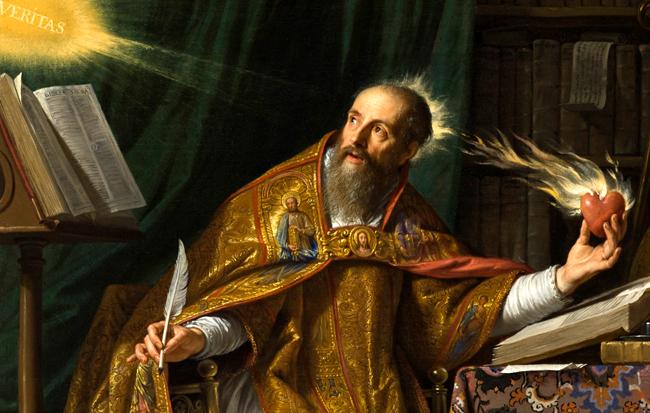 St. Augustine gives us a perfect picture of the
St. Augustine gives us a perfect picture of theintent of a seemingly restrictive set of laws much like the rule of Saint Benedict that we just recently surveyed. The laws of a monastic order were not meant to remove all joy and gratification from life but quite the opposite. The laws were meant to align ourselves with a lifestyle that has no distractions but only reinforcements to 'forget about satisfying your bodies with all their lusts,' and to fix your eyes on the grace given to you in Jesus Christ. The laws of a monastic order were meant to place the members in relationship with each other to pursue God and love the community they were in. Augustine's journey from youthful hedonism to Christian piety was the result of an early adulthood of self indulgence and deep rooted sin of taking many mistresses and glutenous consumption of wine and food. This would all come to an end when Augustine heard the story of two young imperial officials, engaged to be married (just as he was), who had thrown it all away to come celibate monks out of reverence for Christ and the grace that He he had made know to their hearts through His gospel. After this experience, Augustine was lead into the streets where he thought to have hear the audible voice of God telling him to read from the scriptures. Upon the obedience to this voice, Augustine read these passages: "No drunken orgies, no promiscuity or licentiousness, and no strife or jealousy. Let your armor be the lord Jesus Christ, and forget about satisfying your bodies with all their lusts" (Romans 13:13, Ephesians 6:10-18). Out of this dramatic conversion experience came a heart that was unable to do anything other than please the Lord through the obedience to His word and the brotherhood of the monastic order he was placed into. Monastic Laws of various kinds were only meant to remove distractions from the life of a person seeking to serve God.
 Though Augustine predates the Rule of Saint Benedict, I merely use the document as an example of a set of laws that the monastic order Augustine subscribed to would have most certainly upheld. In our 21st Century Western culture, we view these laws and rules as
extremely restrictive and oppressive but we must remember that given in their proper context,
these rules were received as a necessary removal of distractions and a
support system for those seeking to know God more fully. Not a restriction but a means to flourish.
Though Augustine predates the Rule of Saint Benedict, I merely use the document as an example of a set of laws that the monastic order Augustine subscribed to would have most certainly upheld. In our 21st Century Western culture, we view these laws and rules as
extremely restrictive and oppressive but we must remember that given in their proper context,
these rules were received as a necessary removal of distractions and a
support system for those seeking to know God more fully. Not a restriction but a means to flourish.
References
Bennett, Judith M. Medieval Europe: a short history. New York, McGraw-Hill, 2011.
Order of Saint Agustine. Digital image. Diocese of Cochin. N.p., n.d. Web. 7 Sept. 2017.
Bennett, Judith M. Medieval Europe: a short history. New York, McGraw-Hill, 2011.
Order of Saint Agustine. Digital image. Diocese of Cochin. N.p., n.d. Web. 7 Sept. 2017.
St. Augustine of Hippo. Digital image. The Unbounded Spirit. N.p., n.d. Web. 7 Sept. 2017.



Bridger, this was very well written and extremely well thought out. I appreciate the lens that you used to look at the rules of a monastic order as a way to pursue a meaningful relationship with Christ and not just simply a set of laws to be followed.
ReplyDelete